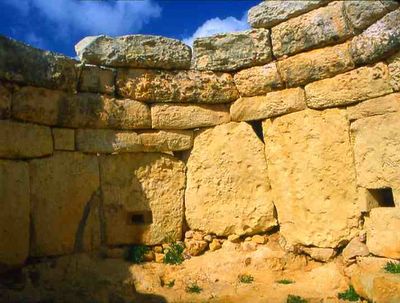
We pulled into the small dirt parking lot that sits near Malta’s Neolithic temples of Hagar Qim and Mnajdra and handed our money to a man who looked like Popeye. His face was grizzled by sun and sea spray, his teeth were several short of a full set, and his sailor cap sat high and to one side, calling attention to his large walnut forehead. He was delighted to see the kids, and he dug around in the pockets of his baggy pants and produced two fistfuls of hard candy, which Adam and Dana sucked on while listening to his tales of the mystical structures we were about to visit. Before we headed off to the temples, he promised to personally guard our car and pointed us to the free toilets. “Don’t use the toilets in the Hagar Qim Restaurant. You have to pay fifty cents each.”
After we saved a dollar and a half, we headed over the rise and were greeted by the magnificent sight of Hagar Qim and Mnajdra sitting on a sweeping hillside above the sea. Below the massive, 5000-year-old limestone ruins, terraced vegetable plots ran to the cliff edge, and ship-shaped Filfla, Malta’s smallest island, floated in the near distance. The temples are splendid, the setting glorious.
The kids took off down the path that led to the temple complex, a place older than the pyramids at Giza. Malta, which sits in the Mediterranean northeast of the Tunisian coast and some 50 miles south of Sicily (Maltese travel agencies offer quick trips via high-speed hydrofoil to both places) has a rich, remarkable history, and even before the peripatetic Phoenicians found it as they cruised their world, Malta was home to an organized society of temple-builders who worshiped the Mother Goddess and erected complexes like Hagar Qim, Mnajdra and Ggantija on Gozo, the second largest island in the Maltese archipelago.
The island nation of Malta is peppered with spectacular megalithic temples erected by the ancients to venerate their goddess of fertility, and some of the complexes are, themselves, shaped like robust, pregnant women. “This room is the belly,” I said to the kids as we explored Ggantija, Gozo's "place of giants.” (They didn’t say “yuck.” My kids are cool.) The people who built these temples also carved statues and statuettes of healthy, round women, and seven of them, including the famous (and tiny – just a few centimeters high) “Venus of Malta,” were found at Hagar Qim, which means “standing stones” in Maltese (Malti).
The statues and figurines are poignantly beautiful and simple. Like the Maltese landscape, stark and unadorned. Unearthed from their temple homes, most of the statues of ancient Malta’s “fat lady culture” now rest in the National Museum of Archaeology in Valletta, Malta’s capital and a World Heritage Site. The museum, which boasts a vivid central ceiling fresco, was built in 1571 as an auberge for the Knights of Malta. As you make your way through the building to view the exquisite fat ladies, you can walk atop sections of floor that have been peeled back and replaced with Plexiglas to afford views onto stone steps and vaulted chambers that run below street level.
In a souvenir shop near the museum, I bought a cheap copy of a Malta fat lady. White, pure, basic. She sits in the sun by my living room window on a green marble tabletop that she shares with two other small, simple, white objects I’ve collected in my travels – a slab of antique Chinese white jade the size of a deck of cards depicting a bustling family scene (pre-one child policy days), and a knock-off of an ancient Greek Cycladic sculpture of a serene, hairless, goddess, sleek and chiseled except for her pregnant middle. I have the two goddesses facing each other so they can dish and enjoy some girl talk.
(A warm hello to Robert Micallef, a Maltese economist who found my blog and enjoyed a November post about horse racing in Marsa, Malta, Robert's father's hometown. Robert's blog, Wired Temples, is about all things Maltese. Check it out. One of the joys of publishing this blog is "meeting" people from around the world. I love opening my emailbox and finding a message from a faraway reader. Since starting this blog in October, my book website, LoriHein.com, has been visited by people from China, Iran, Mexico, the UK, Germany, the Philippines, Japan, Saudi Arabia, Kuwait, Canada, Greece... I continue to be amazed at the combined power of words, pictures, travel and the Internet to bring people together. Thanks for letting me share my stories with you. Where shall we go next?)
